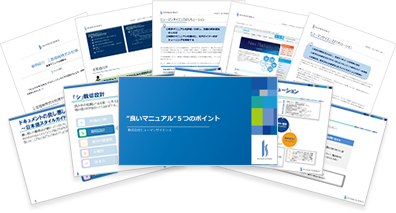
Hello! I am Consultant S.
I usually handle manual creation and improvement projects for companies in the manufacturing and insurance industries. This time, let's think about "the personalization of operations." I will also introduce examples of companies that are challenging to break away from operational personalization with the goal of "changing the company culture through manual creation!" Please pay attention.
- Table of Contents
1. What is business personalization? What are the causes?

First, let's take a look at what the personalization of work means, what causes it, along with some examples.
The personalization of business refers to a situation where specific members are responsible for specific tasks, and the knowledge and skills related to those tasks are concentrated in those members. In other words, it creates a situation where other members must rely on those members to perform the same tasks.
Below, I will provide some examples of the causes and consequences that lead to the personalization of work.
●Cause 1: Uniqueness of the Business
Tasks that require special skills tend to become dependent on specific individuals.
For example, in IT projects that use specialized programming languages, work cannot be performed without engineers who know that language, leading to a dependency on them for operations. Additionally, in manufacturing lines, if there are only a limited number of workers who can operate specific machines, the absence of those workers can cause work to stagnate and potentially harm productivity.
●Cause ②: Lack of opportunities for information sharing
When there are few opportunities to share business information among members, it becomes easier for tasks to become personalized.
This is the case when there are no meetings among members doing the same tasks, or when there are no shared documents to record business information. In such situations, information about how other members work and the points they pay attention to is not shared, leading to a black box in the business process. Additionally, if the methods of members who are working efficiently are not shared, it does not contribute to improving the overall performance of the organization.
●Cause ③: Psychological resistance to sharing information
When there are members who take great pride in their work and hesitate to share information, it becomes easier for tasks to become personalized.
For example, among high-performing sales representatives, there are those who show strong resistance to sharing their sales know-how with others. As a result, information sharing within the organization stagnates, making it difficult for new ideas and effective strategies to spread. This may often occur in companies with a strong culture of "learning by watching others."
In this way, the personalization of work occurs due to various reasons, reducing efficiency and negatively impacting the overall performance of the organization.
So, what measures can be taken to break free from the personalization of work? Let's take a look in the next chapter.
2. How to Break Free from Job Dependency?

To eliminate the personalization of work, the following methods are effective.
●Creation and Utilization of Manuals
We create manuals that compile business procedures and knowledge, allowing all members to utilize them for skill sharing and standardization of operations.
●Communication Enhancement
By establishing regular meetings and information-sharing sessions, we promote communication among members and facilitate the sharing and transmission of skills.
●Skill Development Support
By providing opportunities for training and workshops, we ensure that every member can acquire the necessary skills to perform their duties.
Our company has supported various businesses in "the creation and utilization of manuals."
As a representative example, let me introduce the efforts of a company I assisted in breaking away from the personalization of work through manual creation.
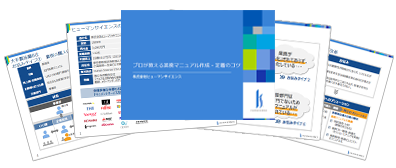
3. Can Manuals Change Company Culture!? A Case Study of an Automobile Manufacturer

This is an inquiry from the quality assurance department of an automobile manufacturer.
The mission of the quality assurance department is to "support the operations of the design department." At that time, the lack of knowledge transfer from veteran engineers to younger staff was a challenge for the design department. With the urgent need to develop young talent, we wanted to document the know-how held by veteran engineers to facilitate technical transfer. However, it was difficult to ask busy engineers to create manuals, and they were looking for a company that could handle outsourcing.
It can be said that the "special nature of the work" in automobile parts design, along with the "lack of opportunities for information sharing," contributed to the situation of work becoming overly dependent on specific individuals.
As a result, we were able to achieve actual effects by advancing our efforts as follows.
Please scroll horizontally to view
|
Initiatives |
●Step 1: Understanding the Current Situation and Designing the Ideal State Analyze current issues through "analysis of existing manuals" and "surveys/interviews with employees," and design the ideal state of the manual to resolve those issues.●Step 2: Manual Creation Create the manual while dividing roles with the customer. |
|---|---|
|
Effect of Initiatives |
●We were able to document information that previously only existed in the minds of veteran employees, which contributed to the development of younger staff. ●By having the opportunity to exchange business information during the process of creating manuals, we recognized the importance of communication between the instructors and the learners, which also led to a change in employee awareness. |
Below, we will explain the specific initiatives.
■Step 1: Understanding the Current Situation and Designing the Ideal State
First, we started with "Understanding the Current Situation."
At Human Science, we do not write manuals haphazardly. We prioritize understanding our clients' concerns and what they want to achieve through existing manuals, and we carefully consider the information and level of detail that should be included in the manuals, reaching an agreement with our clients. Neglecting this approach can lead to manuals being created solely based on the intentions of the production company, which does not contribute to solving the clients' problems.
We have progressed in understanding the current situation for this automobile manufacturer through the following initiatives.
●Evaluation and Analysis of Existing Manuals
We analyzed the manuals provided by our customers to understand what is unclear and why they are not being utilized.
▽Manual Evaluation Analysis Report
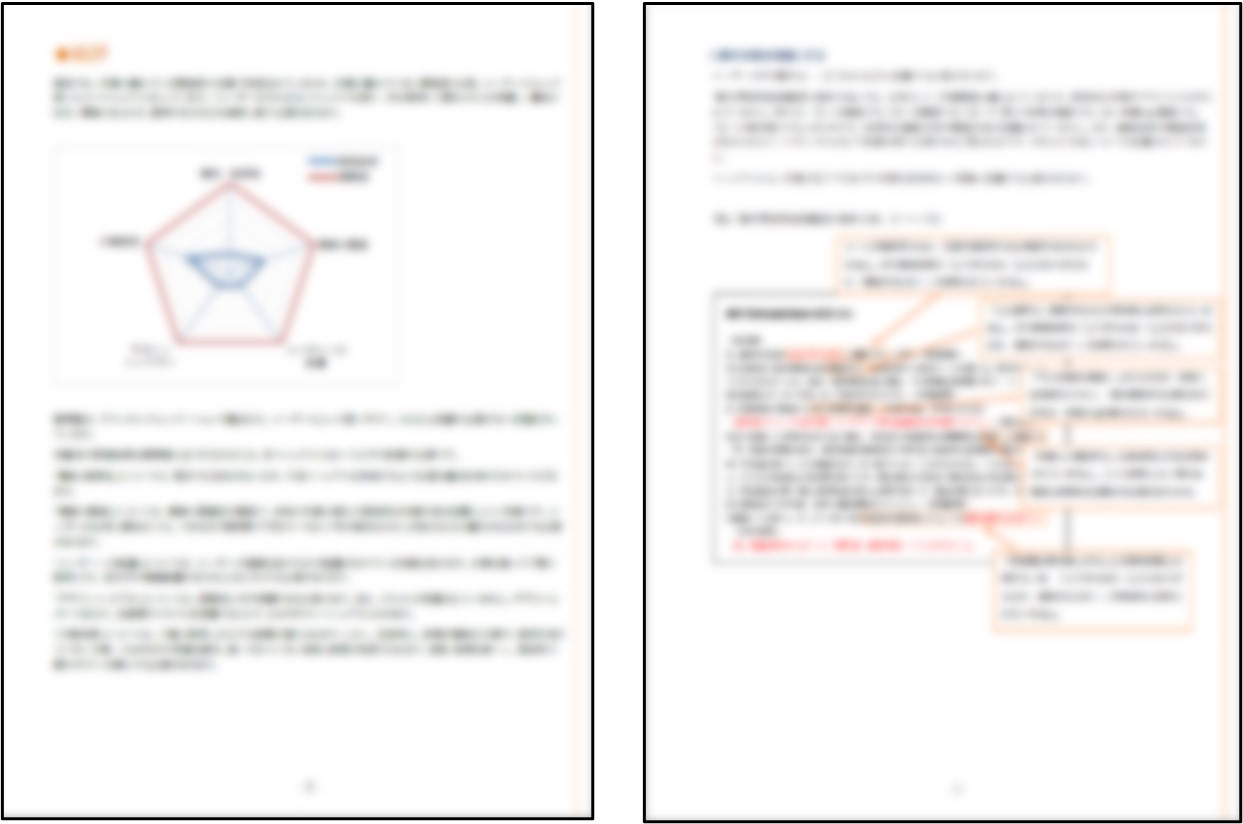
Our company analyzes manuals based on the following perspectives, understanding "for whom" and "for what purpose" they were created.
・Structure・Searchability
Reference: Tips for Creating a Table of Contents to Improve Manual Searchability and Escape from Not Being Able to Find What You Want
・Information Organization
・Design・Layout
Reference: What is a user-friendly manual design?
・Written Expression
In this customer's manual, a major issue was that it did not capture the reader's level of understanding.
For example, even if there is a step that says "investigate ~", without information such as "how to investigate?" or "will the results of the investigation be communicated to someone? Will they be documented and stored somewhere?", young engineers, who are the readers, will be at a loss. Without consideration for the reader, the conclusion becomes that "it's faster to ask someone," which leads to the manual not being adopted.
Of course, we have never been involved in automobile manufacturing as engineers, but from the perspective of a manual professional, we help identify the current issues with manuals. There are many aspects that can be noticed precisely because we are in an objective position that is not familiar with the business.
●Survey and Interviews with Design Department Members
While evaluating and analyzing the existing manuals, we also gathered feedback from members of the design department.
In this case, the quality assurance department raised the question, "Do the members of the design department even need the manuals?" Therefore, we conducted a survey with the following questions:
・Would you like to use a manual that summarizes the design procedures?
・In what situations would you like to use the manual?
・What kind of information would be good to include in the manual?
・What information is difficult to document and can only be taught verbally? etc.
▽Example of Survey Results
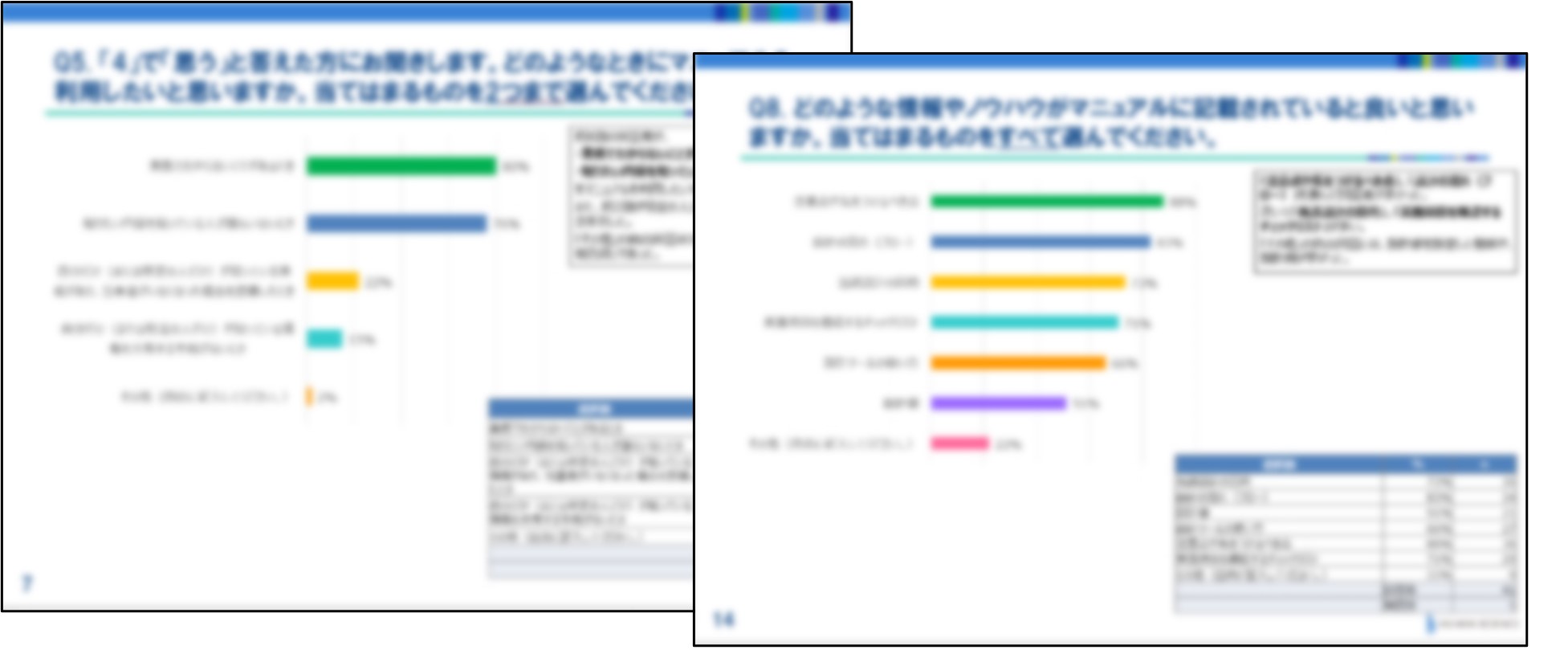
In particular, we received valuable feedback from the field on questions such as, "What kind of information should be included in the manual?" and "What information is difficult to document and can only be taught verbally?" This information serves as an important criterion for determining "what and how detailed we should ask/write" when interviewing clients about their operations or writing manuals.
Example of reflecting survey and interview results in the manual
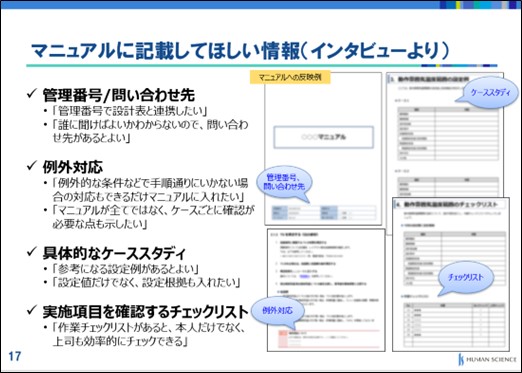
■Step 2: Manual Creation
After understanding the current situation through both the evaluation and analysis of existing manuals based on a professional and objective perspective, and collecting feedback from design department members through surveys and interviews (gathering voices from the field), we began the manual creation process. The completed draft was then reviewed by the client from the perspectives of whether "the issues highlighted in the evaluation and analysis have been addressed" and "the opinions raised in the interviews and surveys have been reflected."
By conducting a "current situation assessment" and sharing it with stakeholders before starting the manual creation, the perspectives during the draft review become clearer.
After completing the first manual through this process, the client strongly expressed the desire to be able to write manuals themselves for future needs, and they began to promote in-house manual creation.
That said, it is difficult to become self-sufficient immediately. First, we decided to proceed with a division of roles as follows:
・Business organization: Client
・Turning organized information into a manual: Human Science
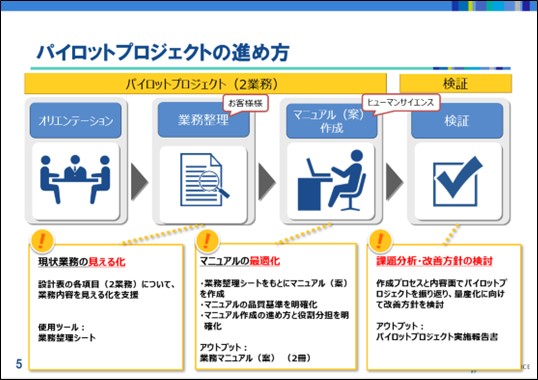
In the "Business Organization" process, we used our unique business organization sheet, and the progress was primarily driven by the customer.
Reference: Having just a template is not enough! The essential first step for a business manual
At this stage, I remember that communication among customers became very active. During the meetings, conversations among customers increased, such as, "For this process, I do it this way." "Oh, really? I was doing it like this." "Each method has its own advantages and disadvantages." In fact, it is common for the exchange of business information to be promoted during the process of creating manuals.
After that, based on the business organization sheet created by the client, we proceeded with the manual creation.
Even companies that are not familiar with manual creation can efficiently create manuals by sharing the process with professionals. We received the following feedback regarding the division of roles this time.
・By entrusting the key process of finalizing the manual to professionals, the quality of the manual has been ensured.
Business improvement activities such as manual creation tend to be postponed, but by having an external partner lead the way, we were able to proceed in a planned manner.
Currently, it seems that this customer is promoting the development of young talent through manuals.
"I want to change the company culture starting with the creation of manuals. While 'learning by watching' is good, if both the teachers and learners can communicate more with each other, it will further alleviate the personalization of work," they said, setting a high goal of "changing the company culture."
We have introduced a case study of an automobile manufacturer. How was it?
This was an initiative by our client that promoted internal communication and took a step towards breaking away from dependency on specific individuals through the creation of manuals.
4. Summary
The personalization of tasks can lead to skill disparities within departments and a decrease in operational efficiency. It is effective to start by creating and utilizing manuals, strengthening communication within the team, and supporting the skill development of members. This will help standardize and streamline operations within the department, ultimately improving overall departmental performance.
We hope that our manual creation methods can be of some assistance to your operations.
Human Science also holds seminars to teach methods for creating manuals that visualize operations and break away from dependency on individuals. We invite you to participate in the co-hosted seminar by Human Science.
Human Science Manual Creation Seminar
5. For inquiries about manual creation, contact Human Science
Human Science provides one-stop support from creating manuals in Japanese to English translation.
We have a long history of handling numerous manuals since 1985. If you have needs such as the following, please feel free to consult us.
・I want to improve existing Japanese and English manuals to make them easier to understand.
・I am considering creating an English manual and would like to proceed step by step from the Japanese manual.
・I want to translate and utilize the Japanese manuals created in-house.
Feature 1: Extensive Manual Production Experience with Major and Global Companies
Human Science has accumulated a wealth of manual production experience across various fields, primarily in the manufacturing and IT industries. We have worked with renowned companies such as "Docomo Technology Inc.", "Yahoo Inc.", and "Yamaha Corporation" as our clients.
Case Studies of Manual Production | Human Science
Feature 2: From Research and Analysis by Experienced Consultants to Output
The creation of business manuals is handled by our experienced consultants at Human Science. Our skilled consultants will propose clearer and more effective manuals based on their extensive experience and the provided materials. Additionally, we can create manuals even from the stage where information is not yet organized. The assigned consultant will conduct interviews to create the optimal manual.
Manual Evaluation, Analysis, and Improvement Proposal Services | Human Science
Feature ③: Emphasis on not only manual creation but also support for implementation
Human Science focuses not only on manual creation but also on the important stage of "implementation." Even after the manual is created, we will support its implementation through regular updates and manual creation seminars. Through a variety of measures, we will support the effective use of manuals in the field.
Manual Creation Seminar | Human Science
Thank you for reading until the end.
I hope this blog serves as helpful tips for creating easy-to-understand manuals.
Related Services
◎Business Manual Creation
◎Creation of Operation Manuals
◎Manual Evaluation, Analysis, and Improvement Proposal Services
Manual Evaluation, Analysis, and Improvement Proposal Service
One-Stop Service for Manual Creation and Translation
Tips for Creating and Establishing Business Manuals




















































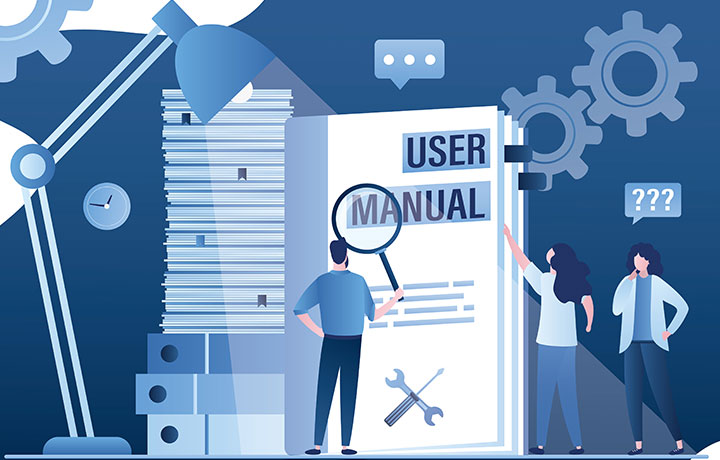









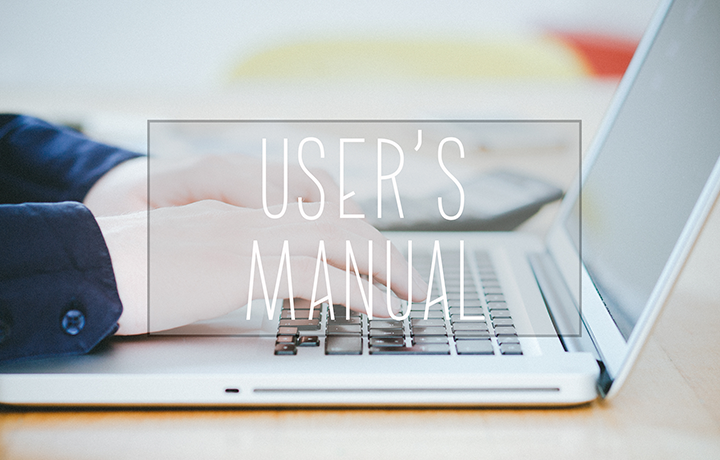












 Manual creation
Manual creation Director, Writer
Director, Writer In-house Support
In-house Support Video
Video Manual
Manual Manual Creation
Manual Creation One-Stop Service for Manual Creation
One-Stop Service for Manual Creation Manuals and Documents
Manuals and Documents